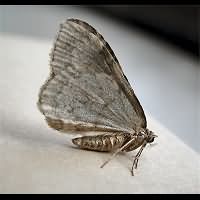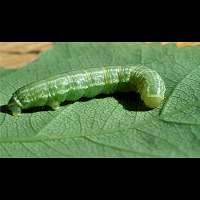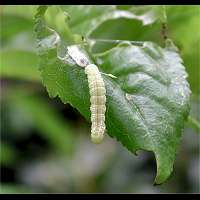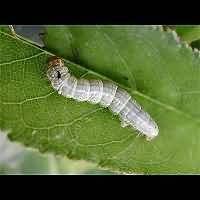Winter Moth (Operophtera brumata)
The Winter Moth is among the more awkward species when it comes to identification. In well marked specimens you'll easily see the brown speckles and spots on the greyish brown upper wing, as well as the light band running across the wing starting about halfways. But most animals are not that neatly marked and look like rather unmarked greyish moths. What complicates matters at times is that the Winter Moth regularly rests with its wings closed together, like butterflies do, hiding the details needed for indentification. It is almost identical to the Northern Winter Moth. Seen together it is not very complicated to separate them: The Northern Winter Moth often shows even less markings, is slightly glossy and lighter in colouration. The Northern Winter Moth flies about earlier than the Winter Moth. The latter however flies longer. In many parts of Britain you have nothing to worry about, for the Northern Winter Moth is very rare at most places, while the Winter Moth is a very common species. The wingspan is some 28 to 33 mm in males. Females are apterous (wingless).
The female just climbs up and down on trees, waiting for a male to appear. After mating the eggs are deposited, either on a bud or on a twig. The eggs overwinter and hatch in April. The young larvae will eat the developing leaves. This way they are sometimes harmful in orchards. If the host plant can't hold all caterpillars or dies, they'll spin a thread and hang down from the tree, waiting for enough wind to let go and be transported to another tree. This way they can turn up in places where no adults were ever seen. By half June they'll make thread and descend to the ground that way. In or on the ground a very tight cocoon is spun in which the caterpillar pupates. In late autumn or early winter the adults appear. The caterpillar is green with a dark green line on top running from haed to tail. Three yellowish or whitish green lines run parallelly on the sides of the animal. The head is green, usually with some small brown markings. It will reach a length of some 20 mm. It will eat almost anything, but prefers trees and shrubs. However in a heath it will nibble on heather as well. The caterpillar in the bottom picture just moulded and that's why it is almost colourless.
The Winter Moth is on the wing from October to December and sometimes seen in January and February as well. During a period of extreme frost however it rests on trees or buildings. The adult moths do not eat at all. Even though the numbers are not the same every year, the Winter Moth regularly appears in really great numbers. It is attracted to light very much and even a lit window has an appeal to this species. If you see a greyish moth flying in the head lights of a car in December, it usually is this species. The Winter Moth just needs a few trees to be present and is a usual visitor to (small) gardens even in towns and cities. A very common species all over Britain and on the continent of Europe, except for mountain areas.
The Winter Moth is among the more awkward species when it comes to identification. In well marked specimens you'll easily see the brown speckles and spots on the greyish brown upper wing, as well as the light band running across the wing starting about halfways. But most animals are not that neatly marked and look like rather unmarked greyish moths. What complicates matters at times is that the Winter Moth regularly rests with its wings closed together, like butterflies do, hiding the details needed for indentification. It is almost identical to the Northern Winter Moth. Seen together it is not very complicated to separate them: The Northern Winter Moth often shows even less markings, is slightly glossy and lighter in colouration. The Northern Winter Moth flies about earlier than the Winter Moth. The latter however flies longer. In many parts of Britain you have nothing to worry about, for the Northern Winter Moth is very rare at most places, while the Winter Moth is a very common species. The wingspan is some 28 to 33 mm in males. Females are apterous (wingless).
The female just climbs up and down on trees, waiting for a male to appear. After mating the eggs are deposited, either on a bud or on a twig. The eggs overwinter and hatch in April. The young larvae will eat the developing leaves. This way they are sometimes harmful in orchards. If the host plant can't hold all caterpillars or dies, they'll spin a thread and hang down from the tree, waiting for enough wind to let go and be transported to another tree. This way they can turn up in places where no adults were ever seen. By half June they'll make thread and descend to the ground that way. In or on the ground a very tight cocoon is spun in which the caterpillar pupates. In late autumn or early winter the adults appear. The caterpillar is green with a dark green line on top running from haed to tail. Three yellowish or whitish green lines run parallelly on the sides of the animal. The head is green, usually with some small brown markings. It will reach a length of some 20 mm. It will eat almost anything, but prefers trees and shrubs. However in a heath it will nibble on heather as well. The caterpillar in the bottom picture just moulded and that's why it is almost colourless.
The Winter Moth is on the wing from October to December and sometimes seen in January and February as well. During a period of extreme frost however it rests on trees or buildings. The adult moths do not eat at all. Even though the numbers are not the same every year, the Winter Moth regularly appears in really great numbers. It is attracted to light very much and even a lit window has an appeal to this species. If you see a greyish moth flying in the head lights of a car in December, it usually is this species. The Winter Moth just needs a few trees to be present and is a usual visitor to (small) gardens even in towns and cities. A very common species all over Britain and on the continent of Europe, except for mountain areas.









